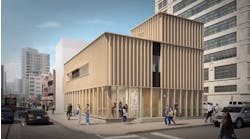The era: 350 BC. The location: Salt River Valley in America’s Southwest. The engineering marvel: a 250-mile-long network of irrigation canals, gouged out with stone tools and wooden hoes, stimulating trade and commerce between communities and people - and what might be considered the first plumbing-related “system” in the United States. Surprisingly, it would take until the mid-19th century before young America would develop reasonably efficient water and sewage systems, according to the “History of Plumbing in America” at (www.theplumber.com). But, American industry made up for lost time: Such insight and innovation eventually resulted in the creation of health and safety standards that are still unsurpassed today.
Plumber.com notes that, in the early 1840s, the architects and planners of New York City’s Central Park denounced the outhouse as “troublesome, unhealthy, indelicate, and ugly,” thus creating Gothic “summerhouse” structures that viewed a garden on one side and a two-holer on the other. In 1829, architect Isaiah Rogers sent ripples throughout the country with his innovative Tremont Hotel in Boston - the first lodging facility to have indoor plumbing, albeit communal washrooms. Five years later, in New York City, he built the Astor House with 17 upper-floor rooms that offered water closets and bathrooms to serve 300 guestrooms.
Buildings magazine’s first year of operation - circa 1906 and published under the name The Building Manager and Owner - offered insight into A Building Without Private Lavatories (the Law Building in Indianapolis): “Public lavatories and toilet rooms are provided on each floor for the men and a single lavatory on an upper floor for ladies, but none of the offices possess its individual conveniences. Even more interesting is the fact that it does not seem to affect the rent roll of the building in the least.”
The year 1906 was also when North Hollywood, CA-based Bobrick Washroom Equipment Inc. (www.bobrick.com) was launched. In 1946, William S. Louchheim purchased Bobrick and began championing a decades-long introduction of non-proprietary dispensers and washroom accessories to the public that continues through the oversight of third-generation Bobrick President Mark Louchheim.
Over his 25-year tenure with the company, Louchheim has intently studied the commercial buildings industry, what he calls “the evolution of the new construction segment,” and the motivation of decision-makers. “Cleanliness and hygiene, as well as maintenance factors and operating costs, continue to be clear issues,” he says. “But, there is now a greater awareness around those issues, particularly as people become more concerned with potential pandemics. One of the key differences today, however, is [washroom] accessories [becoming] part of the initial design as owners and the A&D community consider traffic flow, maintainability, vandalism, and life-cycle costs. Restrooms today help market a facility; therefore, they deserve attention. If they are not clean, well-stocked, or well-lit, you’ll get complaints - or [people] just won’t come back.”
Louchheim notes that flexibility for the building owner is key. “Building owners need to be in control of their restrooms,” he explains. “In some cases, they’ve given up control by [using] free proprietary dispensers from their suppliers. If they decide to make a change, they need to change out the existing product and end up paying a lot more. Owners must take a long-term view in their decisions about design and product selection in order to get optimal results for their investment.”
Such performance issues extend to washroom fixtures as well, which have benefited from more centralized codes and standards - unlike their disparate counterparts in the areas of fire and life safety. Today’s facilities professionals are basing part of their purchasing decisions on the cleanliness and accessibility of their washrooms, says Jon Dommisse, director of marketing and product development at Menomonee Falls, WI-based Bradley Corp. (www.bradleycorp.com), which is celebrating 85 years in business. “But, with tight budget and staffing resources, they are also making sure washrooms are safe and easy to clean.”
Dommisse points to high-durability fixtures and the advent of touch-free technologies - which, he notes, have come a long way in terms of looks and performance. Materials have evolved from the former cast-iron, terrazzo, and vitreous china to solid surfaces, which offer much easier maintainability.
ADA considerations, green/conservation initiatives, and available floorspace are also affecting the decisions that surround washrooms, as well as public expectations. Who would have considered the consumer choice of family restrooms in a shopping mall 25 years ago? Or baby changers in a men’s washroom?
Dommisse sums it up: “Time and money - it’s finding the balance between design, functionality, and durability.”
Linda K. Monroe ([email protected]) is editorial director at Buildings magazine.

